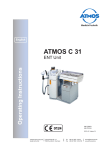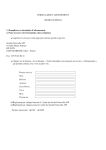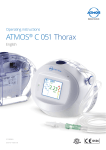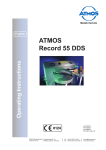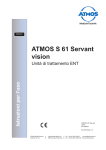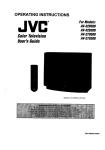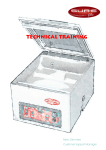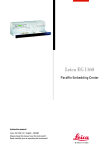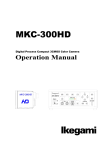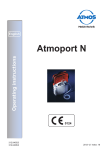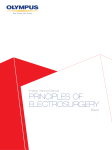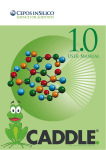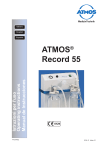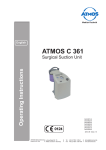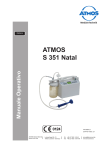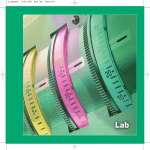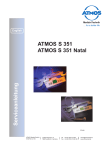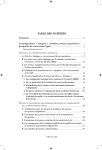Download ATMOS C 31 (GA-en) - This is the ATMOS Content Delivery Network
Transcript
English ATMOS C 31 Operating Instructions ENT Unit 506.7300.B 506.7510.B 2014-08 Index: 33 ATMOS MedizinTechnik GmbH & Co. KG Ludwig-Kegel-Str. 16 79853 Lenzkirch / Germany Tel. +49 (0) 7653 / 6 89-0 Fax +49 (0) 7653 / 6 89-190 [email protected] www.atmosmed.de Contents Introduction Notes on operating instructions ..........................3 Intended use .......................................................4 Function ..............................................................5 Explanation of symbols .......................................5 2.0 For your safety ..................................................6 3.0 3.1 3.1.1 3.2 3.3 3.4 3.5 3.6 Installation and starting-up Front view ...........................................................7 Service compartment ..........................................8 Setting up proposal .............................................9 Connection to electrical power line ...................10 Connection to water supply (optional) ..............10 Water drain (optional) .......................................11 Starting-up the ATMOS C 31 ....................11 - 12 4.0 4.1 4.2 4.2.1 4.2.2 4.2.3 4.2.4 4.2.4.1 4.2.5 4.2.6 4.3 4.3.1 4.3.2 4.3.3 4.3.4 4.3.9 4.3.10 4.3.11 4.3.12 4.3.13 4.3.14 4.3.15 4.3.16 4.3.17 Operation ATMOS C 31 - Basic unit ..................................13 Basic functions ......................................... 13 - 16 Main switch .......................................................13 Maximum loads ................................................13 How to open the covering .................................13 Suction system .................................................14 Emptying the collection jar ................................14 Halogen cold-light system ........................ 15 - 16 Mirror quick heater ............................................16 Options ..................................................... 17 - 24 Ear rinsing system ............................................17 Mirror preheater ................................................18 Collection jar evacuation, fully-automatic .........18 Quiver for cleaning and disinfecting solution .............................................................18 Hose rinsing system .........................................19 Kidney-shaped rinsing basin ............................19 Compressed-air system ....................................20 Connection for warm-light headlamp/ Nystagmus binoculars ......................................21 Headlamp suspension .....................................21 Counter-mirror lamp .........................................22 Endoscope heating ...........................................22 Tongue patches and swab dispenser ...............23 Waste bin ..........................................................23 Microscope .......................................................23 Video system ....................................................24 Tulip-shaped ear rinsing bowl ...........................24 Holder for standard rail .....................................24 5.0 Cleaning .................................................. 25 - 27 6.0 Maintenance and servicing / Safety-related check ............................... 28 - 32 Changing the bacterial filter ..............................29 Changing the tube cassette of the tube pump .....29 Changing the heating coil of the mirror quick heater ............................................30 Changing halogen cold-light lamp ....................31 Changing the halogen bulb of the counter-mirror lamp ..........................................32 Changing the rinsing container .........................32 4.3.5 4.3.6 4.3.7 4.3.8 6.1 6.2 6.3 6.4 6.5 6.6 7.0 8.0 9.0 10.0 11.0 12.0 Trouble-shooting .................................... 33 - 37 Consuming material, accessories, spare parts, options ............................... 38 - 42 Technical Specifications ................................43 Disposal ...........................................................44 Hygiene Plan ............................................. 45-46 Notes on EMC ........................................... 47-49 General Standard Terms and Conditions 2 Page 1.0 1.1 1.2 1.3 1.4 1.0 Introduction 1.1 Notes on operating instructions These operating instructions contain important notes on how to operate the ATMOS C 31 safely, correctly and effectively. Therefore, they are intended not only for new operating personnel to be instructed in its use, but also for use as a reference manual. They help to avoid risks, and also to reduce repair costs and down-time. Furthermore, reliability and service-life of the equipment will be increased. For these reasons these operating instructions must always be kept available near the appliance. Prior to first use please peruse the chapter 2.0 “For your safety”, in order to be prepared for any possible dangerous situations. ATMOS MedizinTechnik GmbH & Co. KG Kudwig-Kegel-Straße 16 79853 Lenzkirch Deutschland Telefon: + (49) 7653 689-0 Fax: + (49) 7653 689-190 + (49) 7653 689-493 (Service Center) e-mail: [email protected] Internet: http://www.atmosmed.de The basic principles are: Judicious and careful work provides best protection against accidents! Operational safety and readiness for use depend not only on your capabilities, but also on care and maintenance given to the ATMOS C 31. For this reason regular cleaning and service work are a must. Major maintenance and repair work may be carried out only by expert personnel authorised by ATMOS. In case of repairs you should insist that original spare parts only are used. You will then have the warranty that operational safety, readiness for work and the value of your appliance will be preserved. These operation instructions apply for the following appliances: ATMOS C 31 Set ...........................Art. Nr. 506.7300.0 ATMOS C 31 Function Column ......Art. Nr. 506.7400.0 Please note that these operating instructions apply for all ATMOS C 31 models and subsequently feature all options and applications. Therefore, it is possible that this document may contain descriptions not relevant for your specific appliance type. The product ATMOS C 31 bears CE marking CE-0124 according to the EEC guideline of the council for medical products 93/42/EEC and meets the basic requirements of annex I of this guideline. The product ATMOS C 31 complies with all applicable requirements of the directive 2011/65/EC restricting the use of certain hazardous substances in electrical and electronic equipment (“RoHS”). The declaration of conformity can be obtained on our website at www.atmosmed.com. The quality management system applied at ATMOS has been certified according to international standards EN ISO 9001 and EN 13485. ATMOS will supply a service manual containing detailed circuit descriptions and schematics as well as information on adjustment and servicing to service organizations authorized by ATMOS. Reprints, also in extracts, only with written permission by ATMOS. Subject to alterations. Errors excepted. Abbreviations / symbols in these operating instructions: Indicating a list • Subdivision of a list/activity. The recommended sequence must be followed in each case! Indicating particularly important advice ! Describing the effect of an activity. 3 1.0 Introduction 1.2 Intended use 1.3 Name: ATMOS® C 31 The ATMOS C 31 is started by activating the main switch Main functions: • Suction • Compressed air module for medication spraying and the Politzer manoeuvre • Ear irrigation • Electric power supply for LED light handles and LED headlight • Light sources • Storage and heating of endoscopes • Mirror quick heater • Instrument deposit and heating Med. indications/ application: Standard ENT examination and/or therapy Specification of the main function: • suction at 40 l/min / -76 kPa • alternatively suction at 55 l/min / -98 kPa • compressed air for medication spraying, max. 2 bar • compressed air for the Politzer manoeuvre, regulated • ear rinsing with 37 °C ± 1 °C, max. 500 ml/min • electric power supply for LED, 700 mA • Light source 15 V, 150 W • Light source 24 V, 150 W Application organ: mouth to pharynx, auditory canal to the ear drum and the nasal cavities Application time: ENT unit: Short term use on the patient (up to 30 days) Suction / Compressed air / ear rinsing / light source: Temporary application on the patient (less than 60 minutes) Application site: Application sites are clinics and practices for ENT doctors and phoniatrists. The examination and/or therapy with the ENT unit may only be executed by medically trained persons. Contraindications: May not be used for irrigation of the paranasal sinuses. The ear irrigation should not be applied to an infected auditory canal or a perforated eardrum. The product is: X active □ not active Sterility: The ENT unit is no sterile product. Single use product / reprocessing: The device and part of the accessories are reusable, for information on reprocessing and disinfection please see the operating instructions. 4 Function (, fig. 1, page 7). The exact mode of function of the standard equipment and optional functions is described in detail in chapters 4.2 bis 4.3.17. 1.0 Introduction 1.4 I O Explanation of symbols On / Off switch Basin rinsing ON (power) as to IEC 417/5007 and DIN 30600/16 Water temperature for ear rinsing too high OFF (power) as to IEC 417/5007and DIN 30600/16 Correct water temperature for ear rinsing Pay attention to operating instructions ! as to ISO /7000/0434 DIN 30600/1008 IEC 348 Water temperature for ear rinsing too low Warm water system Button for increasing lamp intensity Suction system Button for decreasing lamp intensity Compressed-air system Dangerous voltage as to IEC 417/5036, DIN 30600/131 Cleaning in flow procedure (hose rinsing) Protective earth (ground) as to IEC 417/5019, DIN 30600/1545 Cold-light system Fuse as to IEC 417/5016, DIN 30600/0186 Microscope connection (cold light) Type B equipment Headlamp Transfer of heat, in general; mirror heater Type BF equipment (only for cold light) ~ Alternating current Short-time operation Footswitch 5 2.0 For your saftey The ATMOS C 31 is produced according to IEC 601/ Units with water consuming systems may only be switched on when the water supply is guaranteed ! The unit may be connected only to a socket outlet with The ENT unit requires clean water (drinking-water quality) for the operation. In case the clean water cannot be provided by the water supply, a pre-filter has to be installed. The relevant country specific regulations for the instal-lation have to be considered ! The unit should not be positioned directly next to a wall, The control panel must be well visible to and in reach of the operator. Attention! Mirror and endoscope heaters may generate Do not place used contaminated instruments on the ENT unit ! Attention with the cold-light source! The ambient conditions specified in section 9.0 "Technical specifications" must be strictly observed! EN 60601 and listed in the following classes: • VDE Class of protection 1 • Class IIa (EEC 93/42). earthing contact installed according to the rules of the trade. because of the ventilation openings on the rear side ! temperatures above 40°C! Because of the high energy of the light there is a large amount of heat emission at the point of the optical system. Avoid too small a distance between the tissue and the field of light emission of the light guide resp. of the endoscope, as this may cause coagulation of the patient's tissue. When using the endoscope avoid the direct contact between area of light emission and the tissue. Attention, Fire Hazard! Do never place the area of light emission from the light guide or from the endoscope onto heat-absorbing surfaces (dark pieces of cloth, etc.), because this will cause unacceptable high heating or even ignition of the material. Switch the light off when you do not require the light over a prolonged period of time. Care is to be paid in respect to light sources when working with endoscopes. Harmful heat rays are eliminated by special built-in filters: but the intensity of the light is very high. Do not look directly into the light outlets! In case of possible light failure remove the endoscope from the working area. The ATMOS C 31 may be used in supervised operation by qualified personnel only which has been authorised by ATMOS and which has been trained for operating the appliance (IEC 601-1/EN 60601-1). The mains voltage specified on the type plate must correspond with the data of the power supply system. Make sure prior to every application of the equipment that it is technically safe and in proper condition. Damaged leads and hoses must be replaced immediately! The suction system of the ATMOS C 31 is only to be used for the suction of fluids in medical ranges. Never remove explosive, inflammable or corrosive gases or fluids. Switch off main switch after finishing work in practice and close water supply, if present. The ATMOS C 31 may be operated only in rooms used for medical purposes, but not in areas subject to explosion hazards and in oxygen rich environments. The ATMOS C 31 fully complies with the electromagnetic immunity requirements of standard IEC 601-1-2 / EN 60601-1-2 "Electromagnetic compatibility - Medical Electrical Equipment". The ATMOS C 31 may not be operated with units not complying with the requirements of standard EN 60601-1 "Medical Electrical Equipment" and EN 60601-1-2 "Electromagnetic compatibility (Medical Electrical Equipment)". ATMOS is not liable for personal injury and damage to property if • no original ATMOS parts are being used, • the advice for use in these operating instructions is not being observed, • assembly, new settings, alterations, extensions and repairs have been carried out by personnel not authorised by ATMOS. This operation manual corresponds with the construction of the unit and with the current status of safety-related standards at the time of printing. Proprietary rights are existing for all described circuits, processes, names, software programs and units. Please pay also attention to the safety information in following chapters. Please note: A medical insulating transformer with earth leakage monitor or any similar safety system acc. to EN 60 601-1 is required, if several devices are connected over one common power supply. The transformer must correspond to the power consumption of all the devices to be connected. When connecting several devices on one grounding receptacle, the allowed strain and leakage current have to be observed! Never leave the patient unattended at the treatment unit. Display instruments and valves must be checked for correct function in regular intervals ! Inspection of compressed air and vacuum display by service technician every 2 years ! Correct configuration in assembly of country-specific connections: green/yellow: blue: black resp. brown: protective conductor (PE) neutral conductor (N) phase (L) This product is not re-sterilisable. Repeated reuse of components which are marked with a 2 is forbidden. In case of repeated reuse these components lose their function and there is a high infection risk. It is not allowed to use flammable substances with the device. 6 3.0 Installation and starting-up 3.1 3 2 4 Front view 5 6 1 18 17 7 16 15 8 9 14 Fig. 1. 13 12 11 ATMOS C 31 Front view 1 Main switch 2 Sprayer (optional) 3 Laryngoscope holder 4 Surface for medicament bottles etc. 5 Headlamp hook 6 Cover for upper instrument deposit 7 Instrument surface 8 Free surface 9 Drawer or deposit for used instruments (optional) 10 10 Drawer resp. waste pin (optional) 11 Connections for light guide cables 12 Vacuum control 13 Door for service compartment 14 Compressed-air control (optional) 15 Suction 16 Rinsing basin (optional) 17 Compressed-air handle (optional) 18 Rinsing container for hose rinsing (optional) 7 3.0 Installation and starting-up 3.1.1 Service compartment Fig. 2. ATMOS C 31 Service compartment Connection nipple with hose to the vacuum pump (green coding) Collection jar Hose rinsing container (optional) Secretion hose (black coding) Hose for automatic collection jar evacuation (optinal) (transparent coding) Connecting electrodes for automatic collection jar evacuation (optional) Attachment for secretion hose Lid 8 3.0 Installation and starting-up 3.2 Setting up proposal By the option 2 where the instrument deposit is slidable (backwards) an extra 250 mm distance to the wall is required. 560 mm + 250 mm = 810 mm 22.5" + 9.84" = 31.84" 9 3.0 Installation and starting-up 3.3 Fig. 3. Socket outlets with earthing contact Water drainage G3/4" external thread Connection to electrical power line According to the directions of VDE 0107 and VDE 0100, medically used rooms have to be equipped with a leakage current protective circuit (FI protective circuit) with a nominal leakage current of < 0.03 A. Installation must correspond with VDE 0107. The ATMOS C 31 is connected to an earthing contact socket which is to be mounted near the unit (max. 3 m, preferably on the left side, next to the function column (see fig. 1). The power consumption of the ATMOS C 31 comes to 5 A max. For the connection of further electrical devices, please allow for extra plugs. (Installation of an electrically operated patient chair). (optional) Water supply with water tap G 3/4" external thread (optional) 3.4 G 3/4" G 1/2" ≥ 350 Maße in [mm] Dimensions in mm Fig. 4. Water drainage G 3/4" external thread (optional) Water supply G 1/2" internal thread (optional) (with water tap G 3/4" external thread) 10 Connection to water supply (optional) Water supply: Requirements: • There must be existing water pipes with a G 1/2 (internal thread) For connecting a corresponding water or ball valve with a G 3/8 hose connection. • This (water tap) ball valve must be installed in such a way that when leaving the device it can be turned off without any problerm. • The water which is provided by the household connection must at least meet the WHO guidelines or the country-specific guidelines for drinking water. Rinse water supply line in order to remove any con-tamination from the system. When clean water is available, connect delivery hose to water tap mentioned above Required pressure in domestic water system: >2 bar, but <5 bar. There are country-specific regulations for the installation to be considered when the unit is connected to the public water supply . A water connection with pipe ventilation is recommended! There is no special calcification safety device integrated in the water system. Such a system is to be connected when the respective drinking water is of hardness grade 3 (14 21°d resp. 2.5 - 3.8 mol/m³ = hard water) but especially with hardness grade 4 (from 21°d resp. from 3.8 mol/m³ = very hard water). You may receive information on the hardness grade of your water from the water supply office. 3.0 Installation and starting-up 3.5 Waste water drain (optional) Requirements: • Permanently installed connection fitting with G3/4" external thread. To adapt the ¾ draining hose to standard HT 40 a connection adapter 510.2130.0 can be ordered (510.2129.0 for HT 50) Connect waste water hose with unit (, Fig. 5) and the G3/4" connection fitting (insert pertaining seals). Fig. 5. Connection for wase water hose Inlet connector for non-heating apparatus 3.6 Starting-up the ATMOS C 31 Electrical connection • Join the inlet connector for non-heating apparatus(, fig.5) with the earth socket outlet using the mains cable supplied. Waste water connection (with optional automatic collec- tion jar evacuation) • Connect the waste water connector (, fig.5) to the water drain (, fig. 5). Connection of suction hose • Fig. 6. Fig. 7. The transport locking screws on the unit's baseplate must be removed by skilling staff prior to starting up! To do this, the rear panel must be opened and the two front screws must be unscrewed. The pump unit is removed from the rear locking device by pulling it forwards. Collection jar lid with hose coding green: Filter – Pump white, transparent: Collection jar lid – Patient black: Lid– Hose pump Thread the suction hose through the hole on the side into the service compartment and push it straight onto the connector for the secretion hose (, fig. 6). Connection of fibre-optic cable • Plug the fibre-optic cables into the variable connections of the light source (Storz connector). If you require several adapter sleeves (e.g. Olympus, Pentax, Wolf, etc.), they may be interchanged as necessary (see chapter 8.2.4). So that the fibre-optic cables do not rest on the floor, they may be threaded through behind the handle support. Connection of the light guide cables 11 3.0 Installation and starting-up 3.6 Starting-up the ATMOS C 31 (contin.) Light package LED REF 506.7550.0 (Fig. 7a) • Switch LED I and LED II Holder for ATMOS HL 21 LED headlight Holder for ATMOS LS 21 LED light source Connecting socket LED II Connecting socket LED I Fig. 7a. Connecting LED Connecting for the ATMOS LS 21 LED light source and ATMOS HL 21 LED headligt. Connection of the compressed-air hose (optional) Connection of the function hose for compressed air at the side of the column. • Compressed-air hose is connected by means of plug connections; make sure that the plug attachment is engaged. The hose is disconnected by pressing the release slide (, fig. 8) at the plug connector and by pulling out the plug attachment. Fig. 8. Push the handles into the handle support as indicated by the symbols. The photoelectric barriers will operate the wrong pump if the handles are transposed! CPC-Cuppling Connecting the hose for ear rinsing (optional) The hose for the warm water system is screwed on the CPC coupling. Different socket nipples; misplacing of the hoses is thus impossible ! Connecting the hose for ear rinsing (optional) Connect the aqua stop valve with the water tap (local connection). Open the water supply. When the main switch is set to ON and a water consuming device (basin rinsing or hose rinsing system) is used the water supply is opened by automatic opening of the magnetic valve in the aqua stop system. Thus, there is no pressure inside the water supply hose if no water consuming device is activated. Fig. 9. 12 Connecting the hose for ear rinsing Connection for compressed-air hose Connection for ear rinsing hose 4.0 Operation 4.1 ATMOS C 31 - Basic unit The ENT unit ATMOS C 31 offers optimum instrument handling whilst at the same time providing an optimum arrangement of all functions that an ENT specialist requires for his daily work in the practice. The instrument deposit area: At the top of the functional column there is an area designed to take medicine bottles (, fig. 1, page 7), so that the instrument deposit area can be used to its best advantage for instruments. There is also the facility for protective storage of less frequently used instruments and consumables in the drawers ( and , fig. 1). Most of the unit's surfaces are coated with a special textured lacquer that fulfills the requirements for workplace hygiene. However, as the lacquer is not resistant to all medicines and disinfectants it is imperative to wipe up splashes immediately. 4.2 Basic functions 4.2.1 Main switch The ATMOS C 31 is switched ON and OFF by means of the main switch (, fig. 1, page 7). 4.2.2 Maximum loads Persons must not support on the ATMOS C 31 (danger of tilting). Maximum load of the instrument surface: 15 kg. max. 15 kg Maximum load of the writing and working surface: 10 kg. Maximum load of the second deposit surface (optional): 7.5 kg. 4.2.3 How to open the covering Open the unit covering up to the stop. Fig. 10. Maximum load 13 4.0 Operation 4.2.4 Suction system The hose attachment must be exchanged after each patient. ! Prior to each application, proper function of the display instruments and control valves must be checked ! Purpose: • Fig. 11. Suction system Suction attachment Vacuum control Vacuumgauge ON/OFF switch Suction of fluids and secretions; collecting the secretion in the collection jar. Automatic activation of the suction mode by taking out the suction attachment. Control of suction rate by means of rotary knob for vacuum control ( , fig. 11). Indication of set vacuum at vacuumgauge (, fig. 11) (keep suction attachment closed by hand). Secretion is collected in 1.25 l jar with mechanical overflow safety and water-repellent bacterial filter. Prevents ingress of secretion into the pump. Collection jar to be emptied when half full at the latest, see chapter 4.2.4.1! The suction system may be operated only with inserted bacterial filter. In case the filter is blocked it has to be exchanged. (see chapter 6.1) ! For hygienic reasons, the bacterial filter should be exchanged or cleaned daily. The suction hose must never come into direct contact with the application site. Do always use a suction catheter, suction tip, or medical suction set ! Change the suction catheter after every patient and clean the suction hose, e.g. with the aid of the optional hose rinsing system (aspirate rinsing fluid or disinfectant solution)! All commercially available models of suction cannulae (Adson, Walter, Frazier, Fergusson, Plester, Yankauer, Torrington) may be attached to the silicone attachment. 14 Detach all hose connections carefully on the lid system and take collection jar out carefully to prevent spills and contamination of the area. Dispose of secretions properly. Grip lid system firmly, open lid of filter housing by turning in anti-clockwise direction and remove filter. Rinse all parts thoroughly under running water. A detergent or cleaning agent may also be used if required. After cleaning a new filter must be inserted (smooth side down!). See also suction accessories (chapter 8.2.1). Fig. 12. 4.2.4.1 Emptying the collection jar Bacterial filter Secretion hose Green coding ring: pump connection Black coding ring: suction hose connection 4.0 Operation 4.2.5 Fig. 13. Cold-light system Switch for selecting the light exit Intensity control Holder for cold-light cable Endoscope holder Halogen cold-light system Attention with the cold-light source! Because of the high energy of the light there is a large amount of heat emission at the point of the optical system. Avoid too small a distance between the tissue and the field of light emission of the light guide resp. of the endoscope, as this may cause coagulation of the patient's tissue. When using the endoscope avoid the direct contact between area of light emission and the tissue. Attention, Fire Hazard! Do never place the area of light emission from the light guide or from the endoscope onto heat-absorbing surfaces (dark pieces of cloth, etc.), because this will cause unacceptable high heating or even ignition of the material. Switch off the light when you do not require the light over a prolonged period of time. The cold-light source used in the ATMOS C 31 consists of four halogen low-voltage lamps with a colour tem-perature of 3300 K. The halogen lamps are only switched on if the respective light exit is activated. The brightness is individually adjustable for each of the four light exits; a memory function realizes which optics are used and guarantees the availability of the previously set light performance with every use of the chosen instrument. The light guide connectors are installed on the right side of the function column. The respective connections are marked with the cor-responding symbols: Headlamp Microscope Light guide 1 Light guide 2 Starting the cold-light system After having operated the main switch of the ATMOS C 31 (, fig. 1, page 7) the cold-light source changes over to standby mode, i.e. none of the halogen lamps is switched on. • When removing a light guide resp. when swivelling down the microscope or removing the headlamp from its suspension the respective instrument is supplied with light. Manual selection of a light exit on the foil keyboard is, of course, possible at any time. 15 4.0 Operation Priority circuit: Activating the priority circuit: When switching on the ATMOS C 31, keep pressing the +button ( , fig. 14). Deactivating the priority circuit: When switching on the ATMOS C 31, keep pressing the –button ( , fig. 14). Highest priority is allocated to endoscope 1 and lowest priority to the headlamp. Thus, an instrument with high priority (e.g. endoscope 2) is supplied with light even if another instrument with low priority (e.g. headlamp) is already used. When the endoscope is put back the light supply changes automatically to the instrument with lowest priority. Without this priority circuit the light would expire and a manual switchover to headlamp would be necessary. Due to their limited durability, the halogen bulbs of the cold-light system may fail at any time during use. In case of inadvertent switching over or switching off of the individual light exits, they may at any time again be manually switched on with the buttons on the operating panel. The cold-light system is designed for continuous operation in stand-alone application. However, it is possible that the thermal cut-out will be triggered and the cold light will be switched off if it is operated contrary to defined use whilst the suction and compressed-air systems are operated conisly at over-voltage at the same time. The coldlight system will be operable again following a cooling period. Fig. 14. Front foil +Button for activating the priority switching –Button for deactivating the priority switching 4.2.6 Mirror quick heater Switch on the mirror quick-heater with key switch (, fig.15) The mirror quick heater heats up for 10 sec. and switches off automatically afterwards. Supply voltage of the heating coils: 6 V/15 A. Hold the mirror to be heated over the burning heating coil (, fig. 15) located beneath the round grid. Prior to use of the mirror, always check its temperature (with hand etc.) ! Automatic switching to avoid overheating! Safety cover, sleeve and heating element might be very hot. Do not touch directly after heating-up ! Changing the heating coil, see section 6.3. Fig. 15. Mirorr quick heater Key Heating coil 16 4.0 Operation 4.3 4.3.1 Options Ear rinsing system (option) The ear rinsing system is supplied with water by a heated (37°C) 4.5 l storage container (, Fig. 17). This container can easily be filled, cleaned or disinfected. The pump turns on automatically only when pressure drops. Water pressure and flow quantity may be regulated with the release lever on the irrigation handle. With the switch , Fig 17 a, the ear irrigation system can be switched on and off. Switch on the ENT unit only after water has been filled in the storage container of the ear rinsing sy stem. Use e.g. the measuring cup (000.0583.0) to fill the storage Fig. 16. container with water of drinking quality (at least 2 l, max. 4.5 l) and close the lid. Water temperature display The water must not be contaminated and its temperature must not exceed 37°C as it cannot be cooled down. If there is no water of drinking quality available, you may also fill in isotonic saline solution. Alternatively, you may achieve drinking water quality by filtering or boiling the water resp.by adding disinfectants. This system may not be used if the auditory canal is injured as there might be a risk of infection if the irrigation liquid is contaminated. The temperature display indicates the water temperature. It takes approx. 15 min. until 2 litres of cold tap water are heated up to 37°C. Observe the temperature display and check water temperature prior to every application. As soon as the middle lamp is lit the water has reached the desired temperature. Fig. 17. Storage container for ear rinsing 37°C Connection for irrigation handle Irrigation handle Take the water handle out of its holder and spray off water until all air bubbles are removed and the level of the pump noise gets lower (repeat this procedure every time the pump noise gets loud, e.g. after long periods during which it has not been used or after the water level has dropped below the suction limit). Change the jet connection daily. Only use disinfected jet connections to avoid a spreading of germs. Use the hose tip to avoid damages to the tympanic membrane. Cleaning: Empty the storage container and the hose system every evening using the irrigation handle. The remaining fluid can, for example, be removed with the suction system. Fig17a. To avoid a contamination of the storage container please use a disinfected suction attachment. Disinfection: The storage container has to be disinfec- ted once a week with a surface disinfectant (see list of recommended disinfectants in chapter 5.5). The hose system of the ear rinsing equipment has also to be effected disinfected once a week with a hose disinfectant. A measuring of the total number of germs is to be effected in regular intervals. If there is a considerable increase in germs between storage container and irrigation handle a biofilm removing procedure and a special disinfection of the hose system have to be effected by an ATMOS service technician. Fig. 18. Mirror preheater Mirror rack Before cleaning the storage container, switch off the unit as, otherwise, the jar might get too hot when no liquid is filled in. 17 4.0 Operation 4.3.2 Mirror preheater (option) The mirror preheater is switched on when the main switch (, fig. 1, page 7) is activated. The rack ( , fig. 18) containing the mirrors is heated up to about 40°C. ENT unit should be switched on about 20 minutes before starting work, to ensure preheating in good time! Attention, high temperatures ! Prior to use of the mirror, always check its temperature (with hand etc.) ! 4.3.3 Collection jar evacuation, fully-automatic (option) Purpose: • • • Prevents interruption of work in practice. Secretion is not held in jar over a longer period of time. Prevents contact of staff with secretion. Activated automatically when: • • Fig. 19. Service compartment Connecting nipple Collection jar Hose rinsing container (option) Secretion hose Hose for automatic collection jar evacuation Connecting electrodes for automatic collection jar evacuation (optional) Connection for secretion hose Reaching the upper filling limit (electrodes). Returning suction attachment to holder. The tube cassette of the tube pump is a wear part and must be replaced at regular intervals (see chapter 6.2) ! Pay attention to cleaning described in chapter 5.0 ! 4.3.4 Quiver for cleaning and disinfecting solution (option) Cannulae and suction hose should be rinsed through each time after use to prevent sticking and clogging up. We therefore offer an optional quiver that may be attached to the handle support (see fig. 20). After cleaning, cannulae may no longer be used in patients (exception: if the cleaning solution is changed after every patient). Particularly suitable: ATMOS special cleanse (080.0005.0). Fig. 20. Plastic quiver for cleaning and disinfecting solution (506.7015.0) 18 4.0 Operation 4.3.5 Hose rinsing system (option) After use, the suction system has to be rinsed by means of the hose rinsing system. • Insert the suction attachment into the white rinsing attachment of the hose rinsing system. Press the rinsing insert in and rinse the hose for a few seconds. This procedure will prevent the hoses and suction cannulae from clogging up. The tank for the rinsing fluid of the hose rinsing is located in the service compartment at the front of the unit. For optimum cleaning, add the ATMOS special cleanser (Art.No. 080.0005.0) to the rinsing liquid. The tank may, optionally, be automatically filled up with fresh water. Water supply is then controlled by a level switch. A safety switch in the tank holder next to the tank prevents the filling if the tank is missing. Container filling of hose rinsing system: In case of extremely high humidity values, the switch sponge must be replaced in short intervals (approx. every 2 days); otherwise, correct function cannot be guaranteed. The suction attachment of the hose rinsing system may be contaminated. Therefore, it must be cleaned and disinfected daily ! Fig. 21. Float switch Hose rinsing container Line to hose rinsing system 4.3.6 on) Kidney-shaped rinsing basin (opti- Purpose: • The basin receives the water that returns from rinsing procedures of the ear and the maxillary sinus. Remove the basin from its support and hold it under the ear to be rinsed. After use, we recommend to activate the rinsing system. To do so, press the key on the unit; a time mechanism will then start the rinsing procedure (for abt. 10 sec.). Fig. 22. The rinsing basin is not suited to collect large water quantities, e. g. when evacuating a pail, as water might overrun the interior of the unit! Kidney-shaped rinsing basin 19 4.0 Operation 4.3.7 Compressed-air system (option) Prior to each application, proper function of the display instruments and control valves must be checked ! Purpose: • a) Medicaments can be applied to the nasopha rynx. The pump for the compressed-air system switches on after the compressed-air handle has been removed from its holder. Handle is mounted on a sprayer; the top of the com-pressedair handle locks in place in the ring of the sprayer bottle. Available sprayers: • • If a sprayer is used with medication the instructions of the medication manufacturers have to be observed. Do not use the sprayer for the storage of medication ! Caution to be paid to avoid injury when introducing sprayer jet! Fig. 23. Compressed-air system Compressed-air handle Holder for automatic photoelectric barrier control Sprayer suspension Compressed-air control Compressed-air display with straight spraying tube for normal liquid medicaments with twin tube and adjustable angular jet for oily medicaments. Please note, in case the ventilation opening is blocked or the sprayer head is immersed in fluids (e.g. blood, secretion, etc.) a negative pressure could occur and the fluid could flow back into the bottle. In this case the medicine sprayer, sprayer head, flexible nozzle as well as the hose piece for the medicine sprayer must be reprocessed as described in chapter 5.0 cleaning. Operating the release lever. The medicament sprayer is supplied with air and the medicament in the sprayer bottle is atomized. The amount of compressed air is adjusted with regulator ( , fig. 23) in conjunction with the display ( , fig. 23). After use, the medicament sprayer is again inserted in its holder, the bar is pressed, the handle is removed from the sprayer and again inserted in its support. Compressed-air system is again switched off. • b) Politzerisation with Politzer olives or Eustachian catheter can be carried out. Pump switches on after the compressed-air handle has been removed from its holder. The adapter (, fig. 24) supplied for this purpose is locked into the compressed-air handle. Politzer olive (, fig. 24) is inserted in the adapter. Fig. 24. Compressed-air handle with Politzer adapter Compressed-air handle Adaptor for Politzer olive Politzer olive 20 The pressure for the insufflation of the Eustachian tube can be controlled by means of the manometer and the compressed-air regulator. Select an insufflation pressure adapted to the condition of the tympanic membrane. If the tympanic membranes are already pre-damaged even low pressure values might lead to injuries ! Maximum pressure may no exceed 0.2 bar ! Activating, adjusting and regulating the compressed air and switching off the compressed-air system as described above. Accessories, see chapter 8.2.3. 4.0 Operation 4.3.8 Connection for warm-light headlamp/ Nystagmus binoculars (option) After the switch ( , Fig. 26) has been turned on, the headlamp connection is ready for operation. The connector of the headlamp, e.g. CLAR 55 Art.No. 502.0161.0, is plugged into the jack (, Fig. 25) (con-nection cable is included in standard delivery of this option). When connecting nystagmus binoculars (cable available as accessory, Art.No. 502.0141.6), the voltage is reduced automatically (4V) even if you work with low voltage. Fig. 25. Headlamp connection Jack Fig. 26. Care must be taken to ensure that the connection jack and the patient are not touched at the same time when plugging and unplugging the warm-light headlamp! Switch for warm light Cold-light-connection 1 Cold-light-connection 2 4.3.9 Headlamp suspension (option) For storing the headlamp. When the headlamp is suspended again, the cold-light exit is switched off automatically. 21 4.0 Operation 4.3.10 Counter-mirror lamp (option) The counter-mirror lamp (fig. 27) can be mounted to the left side of the column. See separate operating instructions. Fig. 27. Counter-mirror lamp 4.3.11 Endoscope heating (option) Endoscope heating is switched on when the main switch is activated. Endoscopes are warmed to approx. 40°C. Fig.28. 22 Endoscope heating Main switch Sleeves of the endoscope heater ENT unit should be switched on about 20 minutes before starting work, to ensure preheating in good time! The metal quivers of the endoscope holder are to be used solely for holding the endoscopes, these first having been cleaned and disinfected. The metal quivers must regularly be removed and cleaned. Do not fill in any liquids. 4.0 Operation 4.3.12 Tongue patches and swab dispenser (option) The tongue patches and swab dispenser hygienically stores tongue patches and swabs. The whole dispenser may be pulled out at the front for filling or refilling (fig. 29). Fig. 29. Tonue patches and swab dispenser 4.3.13 Waste bin (option) The door of the waste bin (, fig. 1, page 7) is fitted with a "kick box" locking device. The waste bin automatically opens a little by lightly touching the door with the hand or foot. The kick box locks automatically on closing. 4.3.14 Microscope (option) Cold-light microscope on a mount which is secured to the ATMOS C 31. Light is provided via a fibre optic light conductor which is connected to an exit of the ATMOS cold-light system. Refer to separate operating instructions! Only microscopes and accessories approved may be added to the support ! 23 4.0 Operation 4.3.15 Video system (option) In order to make the endoscopic resp. microscopic findings visible to the patient, the ATMOS C 31 may, optionally, be supplemented with a video system, consisting of a camera with endoscopic adaptor as well as a display on the carrying arm. Freezing of the video image is possible with a foot switch (camera accessory). When transferring the video signal to further devices (video printer, video recorder, computer,...), make sure that they are approved medical products. Fig. 30. TFT Display 4.3.16 Tulip-shaped ear rinsing bowl (option) Intended use: To collect the water flowing off during ear rinsing. The tulip-shaped bowl is added to the suction attachment of the suction system. As accessory, we offer a special holder for this ear rinsing bowl. Fig. 31. Tulip-shaped ear rinsing bowl 4.3.17 Holder for standard rail (option) Purpose: For adding disposable collection jar systems. The standard rail holder may be used for one 2 or 3 ljar. ! Maximum load: 5 kg ! 24 5.0 Cleaning 5.1 General information on cleaning and disinfection Set main switch to OFF prior to cleaning and disinfection! The described measures for cleaning do not re place the respective precautions for operating the unit ! 5.1.3 At the end of every working-day, following parts must be cleaned and disinfected: Collection jar with lid system and bacterial filter: • For disinfection, you may use all surface and instrument disinfectants listed on page 26. Always observe the concentration specifications and instructions by the respective manufacturer ! • Do not use • • Collection jar (without autom. collection jar evacuation), bacterial filter and suction hose Disinfectants containing concentrated organic or anorganic acids or bases, since these may cause corrosion damages; Disinfectants containing chloramides, phenol derivatives or anionic tensides, since these may cause stress cracks in the material used for the housing of the unit. • • Pull all hose connections from the lid system and carefully remove the jar from the jar holder in order to prevent a contamination of the area around the unit (e.g. drops). Properly dispose of the sucked material. Take the collection jar at the lid system, open the bacterial filter cover by turning it anti-clockwise and remove the filter plate. Thoroughly rinse all parts under running water. You may, of course, add a cleanser or detergent. Afterwards disinfect all parts. After cleaning and disinfection a new filter must be inserted (smooth side down!). The bacterial filter is a disposable and must be disposed of. The bacterial filter must be exchanged at least once a day. Suction system and hose attachment: • 5.1.1 Cleaning the unit surface The surfaces of the ATMOS C 31 are resistent against all surface disinfectants listed on page 26. Suction capacity is limited by the 1.25 l collection jar. Therefore, do not use more than 1 l rinsing liquid and subsequently evacuate the jar. Replace The filter. Wipe the unit surface with a cloth moistened with a cleaning or disinfecting solution. Wipe dry the device surface, the surface edges may not After every use, rinse out the suction system by drawing in a small amount of irrigating fluid (e.g. ATMOS Special Cleanser 080.0005.0). Keeps the hoses from becoming sticky or clogged. be wet for a longer period. 5.1.2 Cleaning "application parts" 5.1.4 "Application parts" comprise: All single components or assemblies which come into contact with the patient and might get contaminated: • collection jar, • secretion hose, • nozzles of medicament sprayers, • Politzer olives and adapters. The collection jar should be removed and cleaned once every week. • During the cleaning of the jar the cover has to be pulled off and rinsed thoroughly under running water. Use the disinfectants mentioned in chapter 5.4 for disinfection. Before the jar is assembled again, the electrodes in the cover should be cleaned using a wet cloth. All application parts may disinfected with instrument disinfectants (see page 26). All application parts which are exposed to direct contact with the patient during treatment are to be exchanged or cleaned immediately for hygienic reasons. Collection jar and electrodes (automatic evacuation of collection jar) Mistake in polarity not possible! 25 5.0 Cleaning 000.0237.0 5.1.5 055.0029.0 506.5121.0 000.0219.0 ! Medicament sprayers The sprayer tube must be exchanged after each patient. Dismount the medicament sprayer (fig. 32, 506.5120.0; fig. 33, 506.5225.0) and thoroughly rinse all parts under running water. You may, of course, add a cleanser or detergent. • Use water to thoroughly rinse all residues of these substances. 005.0026.0 000.0577.0 Make sure that the air opening is not closed ! When fixing the twin tube nozzle again, make sure that the mark (0,X or milling area) on the nozzle shows upwards ! Sprayer tubes are available as spare parts (see fig. 32 / fig. 33). Fig. 32. 506.5120.0 505.0280.0 055.0028.0 005.0026.0 506.5227.0 (055.0028.0) (505.0280.0) (505.0258.0) (005.0026.0) (055.0021.0) Fig. 33. 506.5225.0 000.0577.0 5.1.6 Instrument trays Before disinfection, thoroughly rinse the trays under running water. You may, of course, add a cleanser (deter-gent) or surface disinfectant. • Thoroughly rinse the trays under running water. Melamine and anodized aluminium trays cannot be sterilised. 5.2 Endoscope quivers The metal quivers of the endoscope holder are to be used solely for holding the endoscopes, these first having been cleaned. The quivers are to be cleaned daily and subsequently disinfected. For doing this, the stopper at the lower end should be taken off. 5.3 Ear rinsing bowl The ear irrigation bowl is not autoclavable! Cleaning and disinfection (also machine cleaning) up to 93°C. 26 5.0 Cleaning 5.4 Recommended instrument disinfectants Manual disinfection of instruments Disinfectant Ingredients (in 100 g) Manufacturer Korsolex extra (Application concentrate) (ethylene-dioxy)dimethanol Glutaral Benzyl-C12-C18-alkyldimethylammonium chloride, tensides, didecylmethylammonium chloride corrosion inhibitors 15.3 g 7.5 g 1.0 g Bode Chemie, Hamburg neodisher MediClean forte (Application concentrate) non-ionic tensides NTA (nitrilotriacetic acid) enzymes, preservative agent <5 g 5-15 g Dr. Weigert, Hamburg 5.5 Recommended surface disinfectants Disinfectant Ingredients Dismozon pur (Application concentrate) magnesium monoperoxyphthalate hexahydrate (in 100 g) 80 g Manufacturer Bode Chemie, Hamburg Green & Clean SK (Application concentrate) alkyl-dimethyl-benzyl-ammonium chloride <1 g dialkyl-dimethyl-ammonium chloride- Metasys, Rum (Austria) Perform Pentakalium bis(peroxymonosulfate)bis(sulfate) Schülke & Mayr, Norderstedt If using aldehyde-containing or amine-containing disinfectants at the same object, this may result in discolourations. 27 6.0 Maintenance and servicing The ATMOS C 31 is equipped with maintenance-free pumps for suction and compressed air. Nevertheless, to ensure correct functioning of the unit over a long period of time simple maintenance work which can either be done by the user himself, or, if desired, by service technicians, is necessary from time to time. • To guarantee correct function of the automatic rinsing and suction mechanism, switch off the ENT unit prior to changing the collection jar. • There is a service compartment (lower part of the function column) which contains the parts needed for the maintenance procedures. The possible maintenance procedures are described in the following chapters. A safety-related check of the ATMOS C 31 is to be effected acc. to the local rules in your country. Nevertheless, we recommend a yearly check acc. to the annexed service booklet. 28 6.0 Maintenance and servicing 6.1 Changing the bacterial filter Set the vacuum regulator (12 , fig. 1, page 7) to "maximum" (right stop). As soon as the vacuumgauge shows a vacuum value to open Fig. 34. DDS bacterial filter >-0.3 bar, while the suction hose is open, the filter has to be replaced. To open the bacterial filter cover please turn it Remove the filter plate and insert a fresh one. Please do only use original ATMOS bacterial filters. The device may never be operated without DDS bacterial filter / oversuction stop. Make sure to clean the electrodes of the automatic collection jar evacuation ! Mistake in polarity not possible! If no vacuum is achieved after switching on again the suction system, check free movement of the float ! 6.2 Changing the tube cassette of the tube pump The tube cassette is located in the unit's pump compartment. It may only be replaced by qualified staff! The tube cassette (, fig. 35) must regularly be changed (approx. once a year) as it may otherwise get leaky. Set main switch to OFF. Clean and disinfect the hose system to avoid splashing of the secretions. Loosen the two hose connections. Remove the tube box from the drive axle by depressing the release lever. Attach the new tube cassette to the drive axle and arrest it in the bayonet holder by lifting the release lever. Pull the tube cassette slightly to check for secure locking. Add the two connecting tubes again acc. to fig. 35. Fig. 35. Pump head and cassette holder to be disinfected by means of spray disinfectant! Take care to ensure that the hoses are not kinked when installing it (shorten them, if necessary)! Hose to the collection jar Release leverl Tube cassette Drainage hose Connecting nipple to the rear wall 29 6.0 Maintenance and servicing 6.3 Changing the heating coil of the mirror quick-heater Grid and sleeve might get very hot. Allow them to cool down before changing the heating coil ! Set main switch of the ENT unit to OFF (, fig. 1, page 7). Remove grid (, fig. 36). Pull out the heating coil (, fig. 37) located under the grid along with its plug connections. Insert a new heating coil and make sure that the three heating helices come into contact only with their ends. Fix the grid again and set main switch to ON. Fig. 36. Mirror quick-heater Grid Fig. 37. Removing the heat 30 6.0 Maintenance and servicing 6.4 Changing halogen cold-light lamp Before opening the lamp slot, switch of the unit ! The lamp and the housing of the cold-light module are very hot after failure ! Allow them to cool down! The lamps of the cold light system are integrated in the function column. The light module can completely be extracted by opening the two locking screws. Thus, the lamps can easily be replaced. Fig.38/a. The lamps are horizontally inserted in a socket from which they can be removed by pulling to the centre of the module. The spare lamp must not be touched with bare fingers (only cut off the top of the foil (fig. 38/b), the rest of the foil remains on the lamp until it is inserted in the socket)! Prior to changing, check on which light exit the lamp has to be replaced ! Do not look directly into the light exits ! Insert the spare lamp in the socket. Fig. 38b. Then remove the foil on the lamp. Make sure that the lamp is inserted in horizontal position ! If lamps are inserted in inclined position or not up to the stop, the light performance is considerably diminished. Slide the light module in up to its stop. Fix the light module again with the two locking screws. Fig.38/c. 31 6.0 Maintenance and servicing 6.5 Changing the halogen bulb of the counter-mirror lamp Allow the lamp to cool down before changing it ! Pull out the plug of the halogen counter-mirror lamp. The halogen bulb is located under two glass disks, which are held with a snap ring. To release the snap ring insert a small screwdriver under the nose of the snap ring and lift it out. Lift out the two glass disks. Remove the reflector of the halogen lamp. When you insert the new lamp make sure that you do not touch the reflector with your bare fingers but use a clean cloth. 6.6 sing Changing the rinsing container Please switch off the unit before removing the rincontainer. To replace the rinsing container, push it all the way up and swing it out together with the level switch. The container must be lifted over the edge of the holder. The container can then be withdrawn obliquely down-wards and outwards. To insert the container, swing the level switch upwards. The container is pushed obliquely upwards to the stop, swung over the edge of the holder and pushed down into the insert (see fig. 39). Fig. 39. 32 Changing the rinsing container 7.0 Trouble-shooting 7.1 Electrical protection The supply line voltage reaches the individual com-ponents via the main switch (, fig. 1, page 7). The power supply is secured by means of melting fuses on the rear of the unit (fig. 40). Fig. 40. Fuse support Before contacting the ATMOS Service, please check your unit acc. to the following charts. 7.2 Power supply Failure with the Unit Main switch is activated, no voltage at the unit, no function, pilot lamps do not light up 7.3 – no voltage to power plug • check fuse, connect other units (lamp) – fuse is defective • replace 10A fuse on the rear of the – power plug or cable is defective • check power plug or cable and – no voltage • check voltage by connecting other con- – heating coil is defective • replace heating coil (section 6.3) to the socket, if necessary unit replace, if necessary Mirror heating Failure with the Unit Mirror is not warmed up with the mirror quick heater – Switch or control unit defect Mirror preheater remains cold – heating plate body in the mirror preheater plate is defective – no voltage suming devices • Call service to exchange the switch or control unit. • have heating plate body replaced by a service technician • check voltage by connecting other consuming devices 33 7.0 Trouble-shooting 7.4 Suction system Failure with the Unit Weak suction or no suction at all No suction, but vacuumgauge indicates -0.7 bar No suction and suction motor does not start No suction; suction motor fails to start although compressed-air pump starts 34 – suction hose is clogged • rinse the suction hose with water – float of overflow safety closes the suction opening – lid of collection jar is not closed tightly – bacterial filter is clogged – hose connections are leaking – connecting hoses in the collection jar compartment are broken – secretion penetrated the suction pump • check filling level in the collection jar – suction hose is clogged • rinse the suction hose with water – float of overflow safety closes the suction opening – bacterial filter is clogged – connecting hoses in the collection jar compartment are broken – overflow safety is closed • check filling level in the collection jar – photoelectric barrier / electronics defective or photoelectric barrier is contaminated • clean photoelectric barrier • have photoelectric barrier checked by – compressed-air handle and suction hose in handle support transposed • position handles corresponding to (hose can also be removing) • check that lid of the collection jar is closed properly • clean or replace bacterial filter • seal up or replace connections • check hose connections, remove breaks • have pump cleaned by service technician (hose can also be removing) • clean or replace bacterial filter • check hose connections, remove breaks • hang up suction attachment, open regulating valve and tap the suction jar; the float balls of the overflow safety must drop back in their resting position a service technician switching function 7.0 Trouble-shooting 7.5 ATMOS cold light Failure with the Unit Lamps fail to light No light at one light exit 7.6 – no voltage • check mains voltage and fuses – lamp drawer not arrested • arrest lamp drawer – thermal cut-out triggered • allow unit to cool down; fuse resets – halogen bulb burnt out • replace halogen bulb (chapter 6.4) – no voltage – electrical defect • check voltage • have the unit checked by a service automatically Compressed-air system Failure with the Unit Compressor does not start technician Compressor fails to start although suction motor starts – compressed-air handle and suction hose in handle support transposed • position handles corresponding to Pressure of compressed air is too low < 2.3 bar – hose connections are leaking • check hose connections • have hose connections inside the unit switching function checked by a service technician Compressed air does not switch off – photoelectric barrier is contaminated or defective • clean photoelectric barrier • have photoelectric barrier replaced by a service technician Sprayer does not work – sprayer is clogged – twin tube nozzle wrongly added • clean sprayer (section 5.1.5) • see section 5.1.5 35 7.0 Trouble-shooting 7.7 Warm-light source Failure with the Unit Bulb on headlmp does not work 7.8 – headlamp is defective – cable or connection is defective • replace halogen bulb • check cable connections Counter-mirror lamp Failure with the Unit No light on counter-mirror lamp – no voltage – halogen bulb is burnt out – transformer on counter-mirror lamp is defective – switch defective 7.9 • check line voltage • replace halogen bulb (chapter 6.5) • have transformer replaced by a service technician • have switch replaced by a service technician Automatic collection jar evacuation Failure with the Unit Secretion is no longer sucked off 7.10 – electrode is contaminated – tube pump defective • switch off unit and clean electrode • replace tube cassette – float-type switch is blocked – float-type switch is defective • clean float tube (re-establishment of Automatic hose rinsing Failure with the Unit Rinsing container is overflowing free movement of float) • inform service technician 36 7.0 Trouble-shooting 7.11 Kidney-shaped rinsing basin Failure with the Unit Rinsing basin does not properly empty – sieve in rinsing bowl is clogged – waste water hoses are clogged • clean or replace the sieve • have waste water hoses checked by a service technician or plumber Basin rinsing does not function at all or only insufficiently 7.12 – rinsing head is clogged (calcified) – rinsing bowl is leaking • decalcify rinsing head • replace rinsing bowl – overtemperature protection switch was activated • Have the switch / control / sensor Endoscope support Malfunction at the unit Endoscope supports are no longer heated exchanged by your service technician. – control is defective – temperature sensor is defective If, nevertheless, the errors cannot be removed inform the ATMOS service staff. Do not start any attempts to repair the unit yourself ! Pay also attention to corresponding chapters in separate operating instructions ! 37 8.0 Consumables supplies, Accessories and Spare Parts, Options 8.1 Consumable supplies 8.1.1 Consumable supplies for suction system DDS bacterial filter, 10 pcs, 50 pcs, 100 pcs..................................................................................................340.0054.0 ATMOS special cleanser for hose rinsing, 500 ml..........................................................................................080.0005.0 8.1.2 Consumable supplies for automatic collection jar evacuation Tube cassette for tube pump..........................................................................................................................069.0126.0 8.1.3 Consumable supplies for optics / light Halogen bulb, 15 V/150 W..............................................................................................................................507.2083.0 Spare bulb for CLAR 55..................................................................................................................................502.0161.1 Spare bulb for nystagmus binoculars.............................................................................................................502.0187.1 Spare bulb for counter-mirror lamp.................................................................................................................505.0620.1 8.1.4 Consumable supplies for water system Hose tips, 30 pcs., minimum quantity: 2 packs...............................................................................................502.0844.0 Collector sieve for rinsing basin, minimum quantity: 10 pcs...........................................................................508.0578.0 Spare filter 100 µm.........................................................................................................................................000.0655.1 Filter support (spare)......................................................................................................................................000.0655.2 Jet connection, short, straight (80mm)...........................................................................................................505.0280.0 Splash protection............................................................................................................................................501.0331.0 8.1.5 Consumable supplies for rinsing basin Collector sieve for rinsing basin, minimum quantity: 10 pcs...........................................................................508.0578.0 Sieve holder....................................................................................................................................................508.0577.0 8.1.6 Further consumable supplies 38 Tongue patches, packet with 6 pcs.................................................................................................................505.0525.0 Cotton roll.......................................................................................................................................................505.0526.0 Waste bags, 50 pcs........................................................................................................................................505.0515.0 Paper for instrument intermediate-deposit, 250 sheets..................................................................................508.0538.0 8.0 Consumables supplies, Accessories and Spare Parts, Options 8.2 Accessories and Spare Parts 8.2.1 Suction Accessories: Suction cannulae (see list, page 13) Spare parts: Article-No. Collection jar 1.25 l.........................................................................................................................................000.0544.0 Bacterial filter cover........................................................................................................................................320.0012.0 Sealing ring for bacterial filter.........................................................................................................................320.0016.0 Collection jar lid..............................................................................................................................................320.0011.0 Sealing ring for collection jar lid......................................................................................................................320.0013.0 Sleeve of overflow safety................................................................................................................................320.0010.0 Float................................................................................................................................................................320.0015.0 Suction hose, silicone, black, intern. diam. 8mm, extern. diam. 12mm, per meter.........................................006.0025.0 8.2.2 Mirror quick-heater Spare part: Article-No. Heating coil.....................................................................................................................................................508.0053.0 8.2.3 Compressed air Accessories: Article-No. Holder for ear speculae / Politzer olives.........................................................................................................508.0545.0 Politzer olives, Teflon, universal size..............................................................................................................000.0241.0 Politzer olives, Teflon, for children..................................................................................................................000.0241.1 Sprayer attachment, straight...........................................................................................................................505.0280.0 Twin tube with nozzle......................................................................................................................................000.0219.0 Sprayer complete, for oily medicaments.........................................................................................................506.5120.0 Sprayer complete, straight..............................................................................................................................506.5225.0 Spare parts: Article-No. Compressed-air handle II...............................................................................................................................506.6202.0 Glass for sprayer.............................................................................................................................................000.0577.0 Attachment for Politzer olives.........................................................................................................................505.0284.0 Twin tube nozzle.............................................................................................................................................000.0219.0 O-Ring.............................................................................................................................................................055.0029.0 Spring clip with roll..........................................................................................................................................000.0237.0 Sprayer head..................................................................................................................................................506.5121.0 Hose, Rilsan...................................................................................................................................................005.0026.0 Medicament glass...........................................................................................................................................000.0577.0 External tube, straight, complete....................................................................................................................505.0280.0 O-Ring.............................................................................................................................................................055.0028.0 Sprayer head II...............................................................................................................................................506.5227.0 See also illustrations on page 25! 39 8.0 Consumables supplies, Accessories and Spare Parts, Options 8.2.4 Optics / Light Accessories: Laryngoscope 70°, 10 mm without light guide................................................................................................950.0151.0 - can be autoclaved - working length: 195 mm Laryngoscope 90°, 10 mm without light guide................................................................................................950.0177.0 - can be autoclaved - working length: 195 mm 4 mm wide-angle optical system, 0°, L = 50 mm, can be autoclaved.............................................................950.0156.0 4 mm wide-angle optical system, 30°, L = 50 mm, can be autoclaved...........................................................950.0164.0 4 mm wide-angle optical system, 0°, L = 180 mm, can be autoclaved...........................................................950.0157.0 4 mm wide-angle optical system, 30°, L = 180 mm, can be autoclaved.........................................................950.0158.0 4 mm wide-angle optical system, 70°, L = 180 mm, can be autoclaved.........................................................950.0159.0 2,7 mm optical system, 0°, L = 145 mm, can be autoclaved..........................................................................950.0160.0 2,7 mm optical system, 30°, L = 145 mm, can be autoclaved........................................................................950.0161.0 Fibre optic cable, length: 1.8 m, 90° Storz angular connection......................................................................508.0664.0 Headlamp CLAR 73, fibre optic cable 2.3 m, Storz, with angular connection................................................502.0515.0 Headlamp, light model, fibre optic cable, straight connection.........................................................................502.0515.5 Headlamp acc. to Binner, Wolf, fibre optic cable............................................................................................502.0516.0 Headlamp CLAR 55, warm light.....................................................................................................................502.0161.0 Connecting cable for headlamp CLAR 55......................................................................................................502.0142.6 Nystagmus binoculars acc. to Dr. Blessing.....................................................................................................502.0189.0 Connecting cable for headlamp CLAR 55......................................................................................................502.0141.6 Teflon element for endoscopes, diameter 2.8 mm - 4 mm..............................................................................508.0777.5 Tank for flexible endoscopes (ATMOS, Olympus)..........................................................................................508.0790.0 Tank for flexible endoscopes (Storz)...............................................................................................................508.0792.0 Adaptor sleeve for Storz connection...............................................................................................................507.0940.5 Adaptor sleeve for Olympus connection.........................................................................................................507.0940.6 Adaptor sleeve for Pentax connection............................................................................................................507.0940.7 Adaptor sleeve for Wolf connection................................................................................................................507.0940.8 Naso-pharyngoscope Ø 3.4 mm, L = 300 mm,...............................................................................................950.0169.0 with removable light guide cable - Direction of view: 0° - Angle of field of view: 95° - Depth of focus: 1 - 50 mm - Angle: 120° / 180° - Light guide cable: Ø 4.8 mm, 1800 mm, Storz connection with leakage testing device and transport case 8.2.5 Further Accessories and Spare Parts 40 Article-No. Instrument tray set, melamine, consisting of 2 large and 2 small trays..........................................................506.7031.0 Instrument tray set, aluminium-anodized, consisting of 2 large and 2 small trays, holder for ear speculae / Politzer olives..........................................................................................................506.7032.0 Instrument tray set, stainless steel, consisting of 2 large and 2 small trays, holder for ear speculae / Politzer olives..........................................................................................................506.7033.0 Ear rinsing bowl..............................................................................................................................................505.0353.0 Plastic quiver for disinfecting solution, to be mounted to cable holder...........................................................506.7015.0 Instrument intermediate-deposit with paper in large aluminium resp. stainless steel tray.............................. 508.0533.0 Connecting cable for potential balance (5 m).................................................................................................008.0596.0 Instrument tray, aluminium-anodized, 184 x 142 mm.....................................................................................508.0058.0 Instrument tray, aluminium-anodized, 284 x 184 mm.....................................................................................505.0516.0 Instrument tray, stainless steel, 180 x 140 mm...............................................................................................508.0058.2 Instrument tray, stainless steel, 280 x 180 mm...............................................................................................505.0516.2 Instrument tray, melamine, 190 x 150 mm......................................................................................................000.0746.0 Instrument tray, melamine, 300 x 190 mm......................................................................................................000.0747.0 Serrated instrument holder, big.......................................................................................................................508.0566.0 Serrated instrument holder, small...................................................................................................................508.0567.0 Holder for ear speculae / Politzer olives, for aluminium resp. stainless steel tray..........................................508.0545.0 Article-No. 8.0 Consumables supplies, Accessories and Spare Parts, Options 8.3Options 8.3.1 Options, general International power pack: 100V~ – 240V~ ± 10 %, 50/60 Hz.........................................................................506.7000.1 Instrument deposit on additional plane, full pull-out with ball guidings...........................................................506.7030.0 3-fold endoscope holder, heated, incl. metal quiver.......................................................................................506.7016.0 Connection for headlamp / Nystagmus binoculars.........................................................................................506.7012.0 Headlamp suspension with automatic switching function of the light source.................................................506.7013.0 Tongue patches and cotton swab dispenser, combined, to be integrated into Unit Cabinet or Instrument Cabinet with single sub-construction........................................................................................506.7034.0 Cotton swab dispenser in open storage space, in case of 2 Base Cabinets..................................................506.7790.0 Mirror preheater, for approx. 70 mirrors..........................................................................................................506.7025.0 Counter-mirror lamp........................................................................................................................................506.7026.0 8.3.2 Optional Suction System Suction system for higher air-flow rate of 55 l/min, -98 kPa...........................................................................506.7008.0 Collection jar evacuation, fully-automatic.......................................................................................................506.7004.0 8.3.3 Optional Compressed Air Compressed-air system complete with 3 medicament sprayers, 1 Politzer adaptor and sprayer holder.............................................................................................................506.7007.0 8.3.4 Optional Water System Rinsing basin, kidney-shaped, removable, on swivel arm..............................................................................506.7003.0 Automatic hose rinsing system, consisting of:................................................................................................506.7005.0 Rinsing attachment for cleaning cannulae, suction attachment and suction hose with automatic refilling of the supply container in the service compartment. Rinsing attachment, Teflon, for quick change in case of contamination.........................................................506.2228.1 Water system, necessary for options "Rinsing basin" and "Automatic hose rinsing system", ....................... 506.7006.0 consisting among others of supply hose with aquastop valve, pressure reducer, water filter, waste water hose (3m) Water prefilter for ENT Units, can be flushed out...........................................................................................502.0990.0 Decalcifier.......................................................................................................................................................502.0995.0 Covering hose for supply and waste water hode and power line, light-grey, in meters.................................. 005.0029.0 Hose end grommet for covering hose.............................................................................................................005.0030.0 Measuring cup for filling the storage container...............................................................................................000.0583.0 8.3.5 Optional Power Source LCS 100 LCS 100, adjustable power source for warm-light headlamp (2.4-6 V), 1 A), Nystagmus binoculars (1.9-3.5 V, 1 A) and hot cautery (0-6 V, 15A)..............................................................506.5701.0 Cautery handle, Model K. Storz, pistol-shaped, connecting cable.................................................................502.0162.0 Cauter-burner for the nose, platin, length: 10 cm, knife-shaped, flat..............................................................502.0163.0 Cauter-burner for the nose, platin, length: 10 cm, one-side glowing..............................................................502.0164.0 Cauter-burner for the nose, platin, length: 10 cm, pointed.............................................................................502.0165.0 Cauter-burner for the nose, platin, length: 10 cm, ball-shaped.......................................................................502.0166.0 Cauter-burner for the larynx, platin, knife-shaped, flat....................................................................................502.0167.0 Cauter-burner for the larynx, platin, right-side glowing...................................................................................502.0168.0 Cauter-burner for the larynx, platin, left-side glowing.....................................................................................502.0169.0 Cauter-burner for the larynx, platin, pointed...................................................................................................502.0170.0 Cauter-burner for the larynx, platin, ball-shaped............................................................................................502.0171.0 41 8.0 Consumables supplies, Accessories and Spare Parts, Options 8.3.6 Optional HF-Electrosurgery Unit Portable Erbotom ICC 50, mono- and bicoagulator........................................................................................506.5740.0 Monopolar set, comprising: needle electrode, ball electrode, electrode handle with 2 keys, silicone neutral electrode 17 x 11 cm, incl. rubber bandage, cable for neutral electrode.........................................................................................................................................................508.0744.1 Bipolar set, comprising: single pedal switch, bipolar forceps (bayonet), connecting cable............................ 508.0745.0 Biplar coagulation electrode, acc. to Binner...................................................................................................508.0746.0 8.3.7 Optional Diagnostic Otoscope ENT instrument set: diagnostic otoscope with 1 set = 6 pcs. ear speculae for permanent service; 10 disposable ear speculae diameter 4 mm; straight bulb support with laryngeal mirror; tongue depressor; connector for fluorescent examinations and protective cap; nose expander; 1 of each spare bulb.....................................................................................507.0403.0 Heine Loading unit NicaTron NT 200, desk-top unit, without handles...........................................................507.0406.0 Battery handle 3.5 V.......................................................................................................................................507.0405.0 Spare battery..................................................................................................................................................507.0405.1 8.3.8 Optional Microscopy Microscope OPMI pico, installed, objective f = 250 mm, widefield straight tube f = 170 mm, ....................... 506.7022.0 2 spectacle-wearer oculars with 10x magnification, incl. 5-steps magnification changer (0,4x - 2,5x), T-handle, dust cover, cold-light connection 8.3.9 Optional Camera System TFT-Monitor with column carrier arm, consisting of: 15,1" TFT-Monitor with MPG power pack,.................... 506.7011.0 1-joint swivel arm for fixing to microscope column TFT-Monitor with swivel arm, super-flat 15" TFT-Monitor with medical attmittance,.......................................506.7010.0 2-joint swivel-carrier arm mounted to function column, MPG power pack, with video and computer connection CH01-D digital CCD Colour video camera with image memory; optimum colour fidelity,............................... 950.0102.0 very large depth of view without video adapter. System consisting of: - Control unit with 1-chip-camera, PAL system - Integrated image memory for 2 freeze frames - Y/C-cable, FBAS cable, mains supply cable - Dimensions (WxHxD): 90 x 160 x 350 mm - Application class BF Add-on set for camera to Unit Cabinet with single sub-construction, laterally mounted................................. 950.0171.0 42 9.0 Technical Specifications Voltage 230 V~ ± 10 % 50/60 Hz Special voltage (optional): 110 V~ ± 10 % ; 127 V~ ± 10 % 50/60 Hz Current input max. 5 A (230 V~) max. 10 A (110 / 127 V~) Supply Fixed connection, power cable: 5 m Power consumption max. 1150 W Air flow rate of pump 40 l pump: 40 l/min ± 10 % (free flow), vacuum: 90 % of ambient pressure; 55 l pump: 55 l/min ± 10 % (free flow), vacuum: 97 % of ambient pressure; collection jar 1,25 l TPX Cold-light system 4-channels-cold light; processor-controlled, halogen pin socket lamp 24V/150 W, durability: 300 h Ear rinsing system Water temperature adjustment, 37°C ± 2 ° C, filling quantity 4.5 l, flow approx. 450 ml/min Optional compressed-air system 21 l/min ± 10 % (free flow), pressure 2200 hPa Operating time Continuous operation Fuses T 6,3 A (f. 230 V~, 50/60 Hz), T 12 A (f. 110 V~, 127 V~, 50/60 Hz) Protective earth conductor resistance Earth leakage current Enclosure leakage current Patient leakage current max. 0,1 Ω max. 0,5 mA max. 0,1 mA max. 0,1 mA Ambient conditions Transport/storage Operation -10...+50°C; 30...95 % humidity without condensing air pressure 500...1060 hPa +10...+35°C; 30...95 % humidity without condensing air pressure 700...1060 hPa Dimensions HxWxD Column with 1 Base Cabinet with 2 Base Cabinets 93 x 47 x 55 cm 93 x 128 x 60 cm Weight (basic unit) Column with 1 Base Cabinet with 2 Base Cabinets max. 60 kg (with all options) max. 70 kg max. 80 kg Protection class (EN 60601-1) I Degree of protection Type B equipment Type BF equipment (only for cold light) Protection category IPX0 Classification acc. to Annex IX EEC directions 93/42/EEC IIa CE marking CE 0124 Rules applies EN 60601-1: 1990 + A1:1993 + A2:1995; EN 60601-1-2: 1993 (EMV / EMC); EN ISO 10079-1: 1996; EN 60601-2-18: 1996 UMDNS-Code 11-585 GMDN-Code 11585 Reference-No. 506.7300.0 506.7400.0 Canadian Classification Device group PNC Risk Class Description 506.7300.5 506.7400.5 General & Plastic Surgery 79QBU 2 ASPIRATOR, SURGICAL 43 Date of Technical Specifications: 06.07.2011 10.0 Disposal The ATMOS C 31 does not contain any hazardous goods. The material PUR of the housing can be recycled completely. The component parts of the ATMOS C 31 must be disposed of correctly and the materials are to be separated carefully. The electronics circuit boards must be fed into the appropriate recycling process. This document is subject to change without notice. 44 11.0 Hygiene Plan Cleaning and disinfection plan ATMOS C 21 / ATMOS C 31 S Disinfection Sterilisation Who Monthly D Recommendations Weekly C Cleaning When Daily Reusable parts How After each procedure What Qualified and trained staff who are familiar with reprocessing. (Please fill in the responsible person -> use a water-based overhead marker) Secretion canister Bacterial filter cover X X2)4)5) Bacterial filter plate with blue marking (disposable) Sealing ring for bacterial filter Insert of collection jar lid Manual or automatic cleaning and disinfection X Exchange daily or when blockedl X X 2)4)5) X Manual or automatic cleaning and disinfection X X X2)4)5) Manual or automatic cleaning and disinfection X Gasket X X2)4)5) Manual or automatic cleaning and disinfection X Sleeve of overflow safety X X2)4)5) Manual or automatic cleaning and disinfection X Float, closed side must up X X Manual or automatic cleaning and disinfection X X X2)4)5) Empty when the jar is full; at least daily; manual or automatic cleaning and disinfection X Exchange and disposal of full jar X Secretion collection jar Disposable jar system Hose rinsing system Suction nozzle for hose rinsing Silicone attachment piece X X3) Wipe cleaning and disinfection X X X2)4)5)6) Manual or automatic cleaning and disinfection X X X2)4)5)6) Exchange of Silicone attachment Manual cleaning and disinfection after each patient; rinse with hose disinfectant Manual or automatic cleaning and disinfection Rinse the secretion hose with the hose irrigation system after each procedure X Suction nipple with suction hose (reusable) X Secretion suction hose (disposable) X Storage container for hose rinsing system X X X2)4)5)6) Exchange or disinfection monthly X2)4)5)6) Cleaning with a brush; automatic cleaning and disinfection) X X X X Ear irrigation / Thermal nystagmus stimulation Ear irrigation bowl X X2)4)5) Handle X X Jet connection X X2)4)5)6) Splash protection X 3) X2)4)5) Hose tip (disposable) X Wipe cleaning and wipe disinfection X Manual or automatic cleaning and disinfection X Manual or automatic cleaning and disinfection Exchange after each application Hygiene filter Ear irrigation system Manual or automatic cleaning and disinfection X X See operating instructions for hygiene filter X X Empty, dry, wipe, disinfect X Rinse weekly with Bilpron (REF 510.2049.0) 3) X X X Medication nebulisation / Politzer Handle for compressed air Sprayer jet Sprayer head X X3) X Manual cleaning and disinfection Clean after every procedure X X2)4)5)6) Manual or automatic cleaning and disinfection X2)4)5) Multiple rinsing of the sprayer head with water Hose at sprayer head X X Sprayer bottle X X2)4)5)6) Politzer olive X X2)4)5)6) Politzer connection X X2)4)5)6) Weekly exchange of the hose or when changing the medication Cleaning and disinfection (manual or automatic) weekly or when changing the medication Exchange after each application; afterwards cleaning and disinfection Exchange after each application; afterwards cleaning and disinfection X X X X X X X X 45 11.0 Hygiene Plan S Disinfection Sterilisation Who Monthly D Recommendations Weekly C Cleaning When Daily Reusable parts How After each procedure What Qualified and trained staff who are familiar with reprocessing. (Please fill in the responsable person -> use a water-based overhead marker) Endoscope management Plastic quiver X X2)4)5) Cleaning with a brush; disinfect afterwards X Metal quiver X X X Protective sleeve (teflon element for metal quiver) Cleaning with a brush; disinfect afterwards (manual or automatic) X X2)4)5) Manual or automatic cleaning and disinfection X 2)4)5)6) Instrument management Immerse instruments into solution immediately after use, fully wetting is required, air must be removed from any cavities, after the contact time instruments must be rinsed with water, has to be dried and sterilised afterwards. Please also observe the ATMOS operating instructions for ENT instruments. Cleaning with a brush; disinfect afterwards (manual or automatic) ENT instruments X X2)4)5) Instrument bowl with cover X X2)4)5) ATMOS Cam 21 / 31 X X3) Wipe cleaning and wipe disinfection ATMOS Strobo 21 LED X X3) Wipe cleaning and wipe disinfection Flexible scope X1) X1) X1) Immediate pre-cleaning after the procedure X Rigid scope X1) X1) X1) Immediate pre-cleaning after the procedure X Laryngoscope X1) X1) X1) Immediate pre-cleaning after the procedure X Light conductor X X3) Wipe cleaning and wipe disinfection X Light source X X3) Wipe cleaning and wipe disinfection X Microscope X X3) Wipe cleaning and wipe disinfection X Headlight X X3) Wipe cleaning and wipe disinfection X X X X Visualisation X X Radio frequency surgery ATMOS RS 221 (surface) X X3) Ergonomic handles X X1)2)4)5) X1) Wipe cleaning and wipe disinfection X Bipolar tweezers X X1)2)4)5) X1) X X1)2)4)5) X1) Bipolar electrode cable X X1)2)4)5) X1) Neutral electrode X X1)2)4)5) X1) Neutral electrode cable X X1)2)4)5) X1) ENT electrodes X X1)2)4)5) X1) Immediate pre-cleaning after the procedure or dispose of in wet disposal tray; use of enzymatic detergents, cleaning and disinfection (manual or automatic) Immediate pre-cleaning after the procedure or dispose of in wet disposal tray; use of enzymatic detergents, cleaning and disinfection (manual or automatic) Immediate pre-cleaning after the procedure or dispose of in wet disposal tray; use of enzymatic detergents, cleaning and disinfection (manual or automatic) X Bipolar electrode Housing X X3) Wipe cleaning and wipe disinfection X Roller shutter X X3) Wipe cleaning and wipe disinfection X Drawers X X3) Wipe cleaning and wipe disinfection X Writing leaf X X3) Wipe cleaning and wipe disinfection X Instrument deposit X X3) Wipe cleaning and wipe disinfection X Mirror pre-heater Tongue patches and swab dispenser X X3) X X X3) Waste disposal X X Instrument tray X X3) Wipe cleaning and wipe disinfection Wipe cleaning and wipe disinfection, every day or when refilling Wipe cleaning and wipe disinfection, every day or when emptying the container Wipe cleaning and wipe disinfection, daily or when replacing with new instruments Wipe cleaning and wipe disinfection X X X X X X Surfaces 3) Recommended disinfectants 3) Surface disinfection for coated surfaces: Other surfaces: 4) 46 Instruments - manual disinfection: Korsolex® basic (Bode Chemie) Korsolex® plus (Bode Chemie) Korsolex® extra (Bode Chemie) neodisher® Septo MED (Dr. Weigert) neodisher® Septo 3000 (Dr. Weigert) Sekusept® aktiv (Ecolab) Gigasept® Instru AF (Schülke & Mayr) Gigazyme® (Schülke & Mayr) Gigasept FF neu (Schülke & Mayr) Green & Clean SK (ATMOS) Cavi Wipes (Kerr) (USA) Dismozon® pur (Bode Chemie) Kohrsolin® FF (Bode Chemie) Perform® (Schülke & Mayr) Terralin® Protect (Schülke & Mayr) 5) Dismozon® pur (Bode Chemie) Kohrsolin® FF (Bode Chemie) Bacillocid® rasant (Bode Chemie) Mikrobac® forte (Bode Chemie) Perform® (Schülke & Mayr) Terralin® Protect (Schülke & Mayr) Surface disinfection FD 312 (Dürr Dental) Quick disinfection B 30 (Orochemie) X X Important information Wipe cleaning and wipe disinfection: All surfaces have to be wiped with a clean (disposable) wipe which is damped with disinfectant solution; the entire surface has to be wiped thoroughly and may not be dried afterwards. 1) Please observe the manufacturer‘s operating instructions. 2) Alternative to manual cleaning und disinfection: Wash-Disinfector 78°C / 172°F 6) Material dimensionally stable at 134°C Instruments - automatic disinfection: Dismoclean® 21 clean (Bode Chemie) Dismoclean® 24 Vario (Bode Chemie) Dismoclean® 28 alka one (Bode Chemie) Dismoclean® twin basic/twin zyme (Bode Chemie) neodisher® FA (Dr. Weigert) neodisher® FA forte (Dr. Weigert) neodisher® MediClean forte (Dr. Weigert) Thermosept® alka clean forte (Schülke & Mayr) Thermosept® RKN-zym (Schülke & Mayr) Please see the manufacturer‘s instructions for concentration, contact time, temperature and the compatibility of materials. X Wrong concentration of disinfectants may lead to damage! The above stated hygiene requirements are based on the regulations according to the Medical Devices Act, the Medical Devices Operator Ordinance, §18 IfSG and the recommendations of the Robert Koch Institute. Definition of the required reprocessing steps result from the recommendations of the Robert Koch Institute: „Requirements for the reprocessing of medical products“. The medical products were categorised in the risk groups uncritical, semicritical and critical. The reprocessing measures mentioned in this cleaning and disinfection plan are a recommendation of ATMOS MedizinTechnik. Any additional reprocessing measures are at the operator‘s discretion. All the recommended disinfectants which are stated herein are listed disinfectants (VAH/RKI) and have been tested on their suitability of use on the ATMOS C 21 / C 31. ATMOS MedizinTechnik cannot be hold liable for any damage caused by wrong concentration of the disinfectants or by the application of any other disinfectants. Patients with suspicion of a clinical disease or who developed a transmissible spongiform encephalopathy (CJK, vCJK, etc.) have to be treated at facilities which are able to provide for the necessary preventive measures against infection. The reprocessing of the reusable instruments and material may only be performed at facilities which have an externally certified QM Management acc. to DIN EN ISO 13485. The Medical Devices Act, IfSG, the RKI directives, BGR 250 and TRBA 250 always have to be considered. ATMOS MedizinTechnik GmbH & Co. KG Ludwig-Kegel-Str. 16 79853 Lenzkirch/Germany Phone +49 7653 689-0 Fax +49 7653 689-190 [email protected] www.atmosmed.de 2013-12 Index: 04 12.0 Notes on EMC ■ Medical electrical equipment is subject to special precautions with regard to EMC and must be installed acc. to following EMC notes. ■ Portable and mobile HF communication facilities can influence medical electrical equipment. ■ The use of other accessories, other converters and cables than stated may lead to an increased emission or a reduced interference immunity of the equipment or system. 12.1 Guidelines and Manufacturer´s Declaration - Emissions The ATMOS C 31 is intended for use in the electromagnetic environment specified below. The customer or user of the ATMOS C 31 should ensure that it is used in such an environment. Emissions Test Compliance Electromagnetic Environment - Guidance RF Emissions CISPR 11 Group 1 The ATMOS C 31 uses RF energy only for its internal function. Therefore, its RF emissions are very low and are not likely to cause any interference in nearby electronic equipment. RF Emissions CISPR 11 Class B Harmonics IEC 61000-3-2 Class B Flicker IEC 61000-3-3 is conform The ATMOS C 31 is suitable for use in all establishments, including domestic, and those directly connected to the public low-voltage power supply network that supplies buildings used for domestic purposes. The device may not be used directly next to other devices or piled up with other devices. If operation next to or piled with other devices is necessary, please watch the device to check its intended operation in this arrangement. 12.2 Guidelines and Manufacturer´s Declaration - Immunity The ATMOS C 31 is intended for use in the electromagnetic environment specified below. The customer or user of the ATMOS C 31 should ensure that it is used in such an environment. IEC 60601Test Level Compliance Level ESD IEC 61000-4-2 ± 6 kV Contact ± 6 kV Contact ± 8 kV Air ± 8 kV Air EFT IEC 61000-4-4 ± 2 kV Mains ± 2 kV Mains ± 1 kV I/Os Inapplicable Surges IEC 61000-4-5 ± 1 kV Differential ± 2 kV Differential ± 1 kV Common ± 1 kV Common Power Frequency 50/60 Hz Magnetic field IEC 61000-4-8 3 A/m Inapplicable Immunity Test Electromagnetic Environment - Guidance Floors should be wood, concrete, or ceramis tile. If floors are synthetic, the relative humidity should be at least 30%. Mains power quality should be that of a typical commercial or hospital environment. Mains power quality should be that of a typical commercial or hospital environment. Power frequency magnetic fields should be that of a typical commercial or hospital environment. 47 12.0 Notes on EMC Immunity Test IEC 60601Test Level Compliance Level Voltage Dips / Dropout < 5 % UT IEC 61000-4-11 (> 95 % Dip of the UT) for 0.5 Cycle 70% UT (30 % Dip of the UT) for 25 Cycles < 5 % UT Mains power quality should be (> 95 % Einbruch der UT) that of a typical commercial or für 0,5 Periode hospital environment. If the user of the ATMOS C 31 demands 40 % UT continued function even in case of (60% Einbruch der UT) interruptions of the energy supply, für 5 Perioden it is recommended to supply the ATMOS C 31 from an uninterrup70% UT tible current supply or a battery. (30 % Einbruch der UT) für 25 Perioden < 5 % UT (>95 % Dip of the UT) for 5 s < 5 % UT (>95 % Einbruch der UT) für 5 s 40 % UT (60% Dip of the UT) for 5 Cycles NOTE Electromagnetic Environment - Guidance UT is the mains alternating current prior to application of the test levels. 12.3 Guidelines and Manufacturer´s Declaration - Immunity The ATMOS C 31 is intended for use in the electromagnetic environment specified below. The customer or user of the ATMOS C 31 should ensure that it is used in such an environment. Immunity Test IEC 60601Test Level Conducted RF IEC 61000-4-6 3 Veff 150 kHz to 80 MHz Radiated RF IEC 61000-4-3 3 V/m 80 MHz to 2.5 GHz Compliance Level 3V 3 V/m Electromagnetic Environment Guidance Portable and mobile communications equipment should be separated from the ATMOS C 31 incl. the cables by no less than the distances calculated/listed below. Recommended distances: d = (3,5 / V1) * √(P) d = (3,5 / E1) * √(P) 80-800 MHz d = (7 / E1) * √(P) 0,8-2,5 GHz where „P“ is the max. power in watts (W) and D is the recommended separation distance in meters (m). Field strengths from fixed transmitters, as determined by an electromagnetic site (a) survey, should be less than the compliance level (b). Interference may occur in the vicinity of equipment containing following symbol. 48 12.0 Notes on EMC NOTE 1 With 80 MHz and 800 MHz the higher frequency range applies. NOTE 2 These guidelines might not be applicable in any case. The propagation of electromagnetic sizes is influenced by absorptions and reflections of buildings, objects and people. a The field strength of stationary transmitters, such as base stations of cellular phones and mobile terrain radio equipment, amateur radio transmitters, cbm broadcast and TV stations cannot be predestined exactly. To determine the electromagnetic environment in regard to stationary transmitters, a study of the location is to be considered. If the measured field strength at the location where the ATMOS C 31 is used exceeds the above compliance level, the ATMOS C 31 is to be observed to verify the intended use. If abnormal performance characteristics are noted, additional measures might be necessary, e. g. a changed arrangement or another location for the device. b Within the frequency range of 150 kHz to 80 MHz the field strength is to be below 3 V/m. 12.4 Recommended separations between portable and mobile RF Communications equipment and the ATMOS C 31 The ATMOS C 31 is intended for use in electromagnetic environment in which radiated disturbances are controlled. The customer or user of the ATMOS C 31 can help prevent electromagnetic interference by maintaining a minimum distance between portable and mobile RF Communications equipment and the ATMOS C 31 as stated below, according to the maximum output power of the communications equipment. Separation distance, depending on transmit-frequency m Nominal output of the transmitter 150 kHz bis 80 MHz 80 MHz bis 800 MHz 800 MHz bis 2,5 GHz d = [ 3,5 / 3] √P d = [ 3,5 / 3] √P d = [ 7,0 / 3] √P 0.01 0.12 0.12 0.24 0.1 0.37 0.37 0.74 W 1 1.2 1.2 2.4 10 3.69 3.69 7.38 100 11.66 11.66 23.32 For transmitters for which the maximum nominal output isn´t indicated in the above table, the recommended separation distance d in meters (m) can be determined using the equation belonging to the respective column whereas P is the maximum nominal output of the transmitter in watts (W) acc. to manufacturer´s specification. NOTE 1 With 80 MHz and 800 MHz the higher frequency range applies. NOTE 2 These guidelines are not applicable in any case. The propagation of electromagnetic sizes is influenced by absorptions and reflections of buildings, objects and people. 49 For your notes 50 For your notes 51 ATMOS General terms and conditions MedizinTechnik 1. General: case. Should the delivery delay be caused by a culpable infringement is limited to damage which is regarded as typical for tthat case. This Our General Standard Terms and Conditions apply exclusively. Client’s of non-substantial contractual duties, our client is also entitled to claim also applies in the case of our culpable infringement of substantial terms and conditions which are contrary to or deviate from our General a one-off damage compen-sation worth 3 percentage points of the contractual duties The indispensable conditions of German Liability Standard Terms and Conditions are not recognised unless their validity delivery value of the goods for each week’s delay, up to a maximum Law remain unaffected thereby. is explicitly confirmed in writing. Our General Standard Terms and which is no higher than 15 percentage points of the delivery value of Conditions also apply even if we deliver to clients without reservation, the goods - For second-hand equipment, the period of warranty shall be reduced to a period of twelve months. in the knowledge of the client’s contrary terms and conditions. Our General Standard Terms and Conditions also apply to all future business with that client. 7. Delivery - Familiarisation In the case of the delivery of devices for the medico-technical industry which require assembly and/or familiarisation for the final customer using 10. Reservation of Ownership We retain ownership of our goods until the receipt of all payments arising from the business relationship, including all demands arising 2. Proposal - Order Confirmation specialist trade personnel (such as Ear, Nose and Throat Apparatus and from installation orders, subsequent orders, repairs, accessory deliveries Our proposals are subject to change without notice unless otherwise Suction Units), we reserve the right to deliver the goods exclusively to and replacement orders. Should we have agreed upon payment on the stated in our order confirmation. Each order is only accepted by us the relevant specialist traders. Should the trader not carry out assembly basis of cheque and bill transactions, the ownership reservation applies following our written order confirmation. and/or familiarisation for the final customer, this is carried out by us. In until the cheque received byus has been paid in, and does not expire such cases, we reserve the right to charge the client for the additionally through our credit upon receiving the client’s cheque. In the case of 3. Orders created costs. Our specialist traders operate a recording system so a breach of contract by the client, especially payment arrears, we are Every order requires an exact description of all of our product’s details. that, if necessary, our products can be traced to the final customer. The entitled to repossess our goods. Repossession of our goods repre-sents We assume no liability for errors and damage caused by inaccurate or specialist trader undertakes to immediately report to us all events and a withdrawal from the contract, unless explicitly declared in writing by incomplete ordering details. risks which must be reported in connection with our products. us. We have the right to utilise the product after its repossession, whilst 4. Prices 8. Passage of Risk - Packaging deducting appropriate utilisation costs.The client is responsible for the income form such use is balanced against the client’s arrears, after Unless otherwise stated in the order confirmation, our prices in the Unless otherwise stated in our order confirmation, delivery is agreed order confirmation are ex factory prices and exclude packaging and ex factory. The risk of the goods’ damage or loss is therefore transferred be necessary, the client must carry these out punctually at his own cost. value added tax. Packaging is charged separately at cost price in the to the client as soon as the goods leave the factory or the client is in Our client is entitled to sell the goods he has bought from us in a proper handling the goods with care. Should maintenance and inspection work invoice. Value added tax is charged separately in the invoice according default of acceptance of the goods. This also applies to cases where we sale transaction. However, he must immediately assign all outstanding to the legal rate on the invoice date. We reserve the right to change confirm prepaid carriage. Transport packaging and all other packaging claims to the value of the final invoice sum (including value added tax) prices appropriately should price reductions or increases, especially according to the packaging regulations is not returnable. Our client is of our claims to his customers or third parties. The client is entitled to due to wage settlements, changes in the price of materials or currency responsible for disposing the packaging at its own cost. Our deliveries are collect this claim even after such assignment. Our right to collect the fluctuations, be incurred. Proof of such changes will be provided for the insured by us at the client’s expense unless explicitly otherwise agreed. claim ourselves remains unaffected thereby.We undertake to release client on request. No insurance is arranged in the case of goods which are collected by the securities to which we are entitled if requested to do so by the our clients. In the case of transport damage, claims are only handled if client should the realisable value of the our securities be more than 10 5. Payment Conditions - Balancing the client receives confirmation of any damage, reduced weight or loss percentage points higher than the outstanding claims. We reserve the Unless otherwise stated in the order confirmation, our invoices by the shipping company before accepting the delivery. right to choose the securities to be released. 9. Warranty 11. Plans and Illustrations are payable with a 3% discount within 10 days (except for repair and assembly services) or within 21 days from the invoice date net cash; money receipts is decisive for complying with this term. We are entitled The client is responsible for examining the delivered goods We retain ownership of and copyrights to all plans, illustrations, to charge interest after the due date at a rate 2% above the relevant immediately after receiving them to determine any eventual deficiencies calculations and other documents which are attached to our proposals. basic interest rate of the German Federal Bank. Should the client have or delivery errors, and to report these immediately. Should the client The client must receive explicit written permission before passing these payment arrears, we are entitled to charge interest on arrears at a rate fulfil this examining and reporting responsibility, and should payment on to third parties. Imitating our legally patented products is forbidden 5% above the relevant basic interest rate of the German Federal Bank. conditions be fulfilled, we shall be liable to the client within the scope and will be prosecuted. Should we be able to prove higher damages due to arrears, we are also of legal regulations. Our period of warranty shall in all cases be two entitled to claim these. The client only has the right to balance invoices years. Our client can make use of the warranty as follows, so long as against its own claims should such claims be confirmed in a court of he can provide first buyer proof (in the form of an invoice or delivery Our central office is the place of performance for all disputes in law or recognised by us. The client does not have the right of retention note) and provided that the product still has the original, unchanged connection with these General Standard Terms and Conditions and due to disputed counterclaims. serial number: 6. Delivery Periods Fulfilment of our delivery duties requires the punctual and proper 12. Jurisdiction and Place of Performance the contracts closed with clients under them. This jurisdiction excludes a. We choose whether to fulfil our guarantee by providing repair other jurisdiction relating to persons or subject-matter. Furthermore, our services free of charge - either on the client’s premises or in our factory client is not entitled to bring charges against us in another court should - or replacing the product. We can also provide these guarantee he file counter-charges, carry out counterbalancing or declare retention. fulfilment of the client’s duties. The right to defense on the grounds of an services through an authorised company; We, however, are entitled to bring charges against our client at their general place of jurisdiction or at another relevant court recognised by unfulfilled contract is reserved.Should the client default in accepting the b. Should a product be returned to us, the client agrees to send goods delivery or breach other cooperation duties, we are entitled either the product in its original or similar packaging, offering the same German or foreign law.Unless otherwise stated in the order confirmation, to withdraw from the contract or claim compensation for any increased protection as the original packaging, to our address or any address our central office is the place of performance. costs incurred up to that time without setting a further deadline. The right notified by us. to make further claims is reserved. Furthermore, in such cases, the risk c. Our guarantee ceases to apply if changes of any kind have been of coin-cidental destruction or a coincidental deterioration in the quality made to our product, unless such changes have been made by us Lenzkirch, September 2008 of the delivered goods is transferred to the client in the case of default or a company authorised by us, or have been previously agreed ATMOS MedizinTechnik GmbH & Co. KG in accepting such goods or payment arrears. Acts of God or stoppages upon in writing by us. Our guarantee also ceases to apply if third 79853 Lenzkirch/Germany (due to insufficient supplies of material, industrial disputes etc.) entitle parties have carried out repairs to our products or replaced parts us either to demand an appropriate extension of delivery periods or to thereof. This applies regardless of the fact whether these measures partly or entirely dissolve the delivery contract. This does not give the individually or collectively led to a deficiency of the product; client the right to claim damages. We have fulfilled delivery periods if the d. We accept no responsibility for damage defects caused by delivery goods have left our factory or the client has been informed of - operational wear and tear; the goods’ readiness for delivery within such delivery periods. Delivery - incorrect installation or incorrect or insufficient maintenance; periods stipulated by the client are not recognisedby us unless they - incorrect operation of the product (in contradiction to the operating instructions form part of our order confirmation. We adhere to legal terms and delivered with the product); - improper use or operating faults; - conditions in cases where, as a result of an undue delay in the delivery inappropriate or negligent handling and care, especially with respect for which we are liable, the client is entitled to claim that his interests to dirt, lime, suction of fluids, inappropriate cleaning and sterilisation; in a continued fulfilment of the contract have ceased. We also adhere - using accessories and/or replacementpartswhich are not explicitly to legal terms and conditions should a delay in delivery be caused by approved; deliberate or grossly negligent action by us or our representatives for - incorrect assembly and/or initial operation by the client or third which we are responsible. We are also responsible for such actions by parties; - the client’s negligence in handling the product; - unacceptable our representatives or agents. Should the delivery delay not be caused operating conditions, such as humidity, temperatures, the power supply, by our deliberate infringement of contractual duties for which we are vibrations. responsible, our liability is limited to damage which is regarded as typical - accidents, acts of God, especially lightening, water, fire, public for that case. We are liable according to the legal terms and conditions if unrest and insufficient ventilation. We are not liable for damage to and in so far as the delivery delay for which we are responsible is caused other objects apart from our product itself, except in thecase of any by an infringement of a substantial contractual duty. In such cases, our deliberate or grossly negligent actions by us or our representatives or liability is also limited to damage which is regardedas typical for that agents. Should no deliberate breach of contract be claimed, our liability This document is copyrighted. Duplication, translations, microfilming and savings on electronic systems, particularly for commercialpurposes are illegal without prior agreement of the manufacturer. All compiled data are based on manufacturers instructions. All logos, product names and designations used in this document are property of the respective manufacturer. We do not take over any warranty and liability in the case of missing inscriptions. Subject to modifications and amendments.




















































